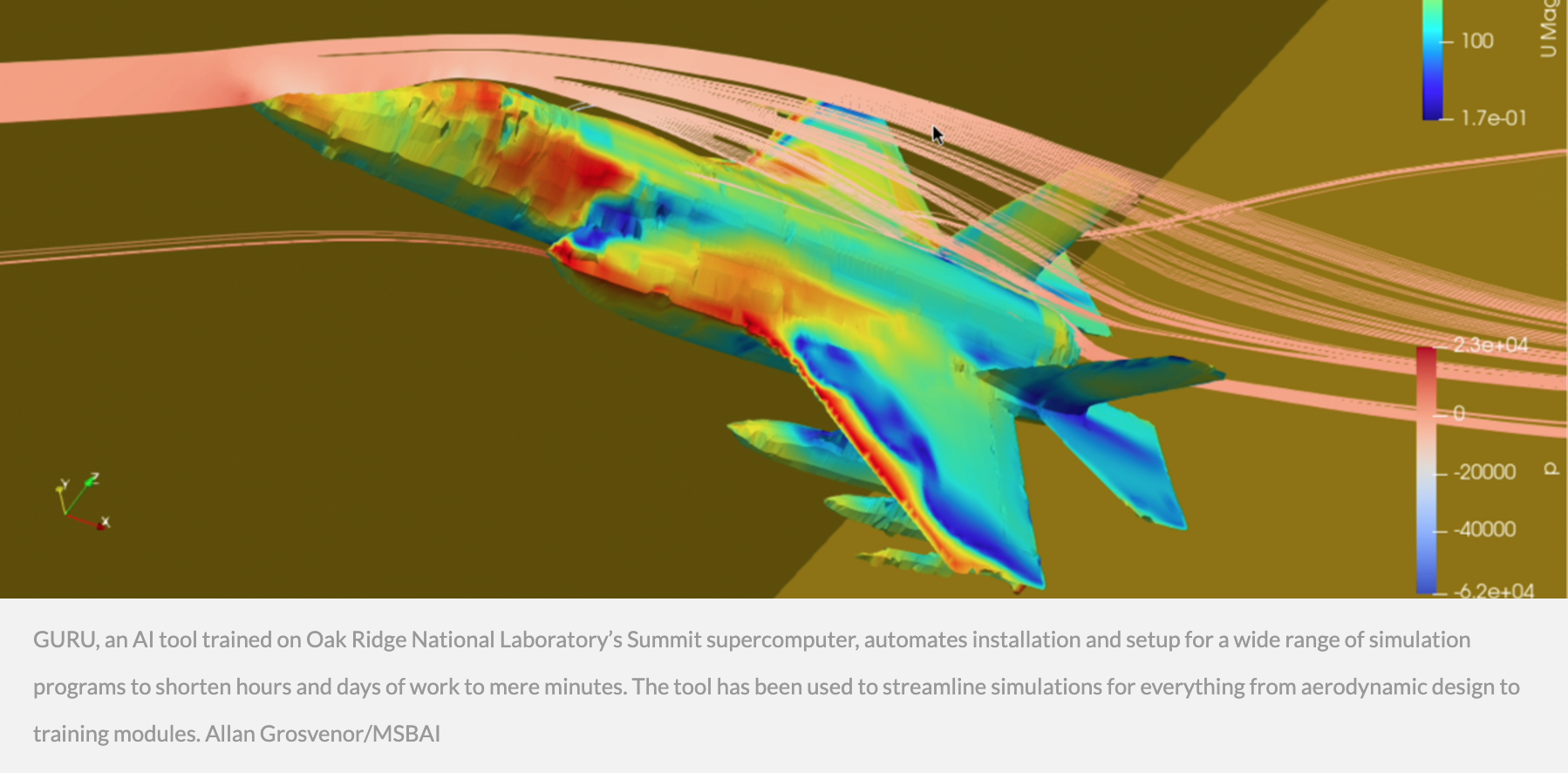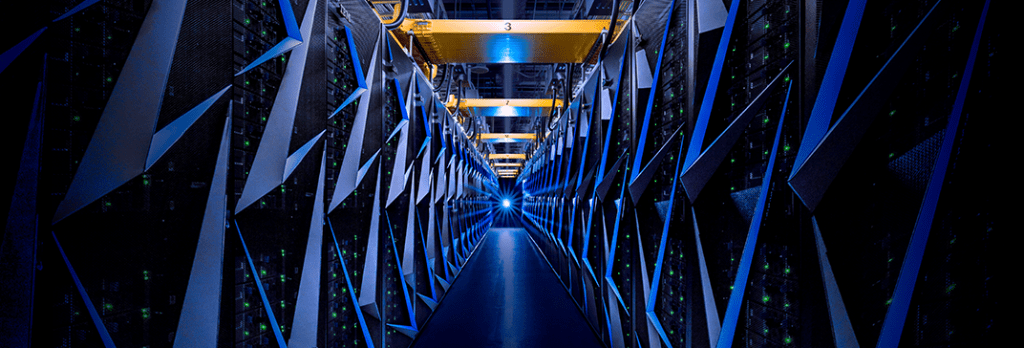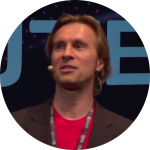Blog
Summit-trained AI brings HPC power to the people

Artificial intelligence has transformed industrial research and development in recent decades during what scientists call “the AI revolution.” The technology enables detailed simulations and high-speed modeling that can streamline the journey from drawing board to production line by speeding up or cutting out costly, time-consuming steps to a practical working prototype.
But those opportunities bring a new challenge: The simplest simulation package may require hours, days and sometimes weeks of training and configuration – even for users familiar with the software’s details and requirements, which often vary from one computing platform to another. The process can cause not just headaches but wasted time and effort for busy engineers and others scrambling to meet tight deadlines.
Simulations performed on the Summit supercomputer at Oak Ridge National Laboratory, or ORNL, could help eliminate that problem. GURU, an AI tool trained on Summit, automates installation and setup for a wide range of simulation programs to shorten that work to mere minutes.
“We saw this problem firsthand in the R&D world and built GURU specifically to solve it,” said Allan Grosvenor, CEO of Microsurgeonbot, or MSBAI, GURU’s creator. “GURU is the brand-new answer to the common question: What’s the on-ramp for specialized simulation software? To set up complex simulations in the real world at a practical scale under aggressive deadlines, you can’t afford to spend huge amounts of time clicking hundreds of buttons in the user interface across five or 10 simulation packages. Too many of these simulation applications take too long for users to learn, and they’re too slow to set up. That means the software is chronically underused by the people who need it most.
“Our estimate suggests as few as 1 percent of industrial engineers are currently using simulation. That’s got to change. Summit has been a total game-changer for enabling us to discover the most data- and time-efficient methods to make setup for simulations doable for our customers.”
THE POWER OF PETAFLOPS
Grosvenor has seen the difference high-performance computing, or HPC, can make in a project as a user of ORNL’s Oak Ridge Leadership Computing Facility, or OLCF, for more than a decade – first as an engineer working on supersonic turbomachinery and later while leading aerodynamic design for a reusable space plane. His early grants of computing time at the OLCF came on Jaguar, which clocked in at top speeds of around 1.7 petaflops, or 1.7 quadrillion operations per second, and Titan, a 20-petaflop system.
Simulating potential designs at the lightning-quick turnaround times offered by Jaguar and Titan enabled Grosvenor to fast-track his work and quickly narrow down options for physical prototypes that could be tested under real-world conditions.
“We were lucky then to be able to get access to that level of computing with that kind of support,” Grosvenor said. “Now petaflop-scale computing can be available to anyone on a cloud-based system, but most of the people who need these simulation packages aren’t experts in making this software work and don’t have time to become experts.”
Users typically need not just one, but dozens, hundreds or even thousands of simulations to test and tweak potential designs and approximate real-world conditions. Engineers commonly consider families of design options with 50 or more variables apiece that dictate the shape of a design. Teams may have to choose from more than a thousand simulation packages that aren’t necessarily compatible with companies’ in-house platforms.
Those users rarely enjoy the same level of support and expertise that OLCF users can count on to make the most of their computing time.
“The time these users are investing in setup is time that could be better spent on analyzing what these simulations tell them and planning what to run next,” Grosvenor said. “We kept hearing from people already using simulation software who’d like to use it more but couldn’t afford the extra time – which is what the simulations are supposed to be saving them.”
Developing a tool to simplify the setup process required enormous amounts of training data and computing power beyond MSBAI’s in-house capabilities.
“We needed the leadership-class computing capability that’s available only at the national labs to test and perfect this tool and to do it in a reasonable amount of time,” Grosvenor said.
DIGESTING DATA
Grosvenor and his team once again turned to the OLCF. The team received access to Summit, then the nation’s fastest supercomputer, which averages speeds around 200 petaflops, or 200 quadrillion calculations per second. The access came through a director’s discretionary grant via the OLCF industrial partnership program, Accelerating Competitiveness through Computational Excellence, or ACCEL.
The computational power of Summit enabled Grosvenor and his team to run extensive tests of the various approaches that could be used to train GURU to guide the simulation software and install it quickly and simply across any computing platform.

Summit, the Oak Ridge Leadership Computing Facility’s 200-petaflop IBM AC922 supercomputing system.
“One of the most important keys to GURU is its learning engine, which enables it to navigate other software and then take the wheel to set up and run the software autonomously,” Grosvenor said. “There are a lot of wrong ways to do that. We used Summit to speed up our discovery of the best and most efficient ways and to narrow down the methods to get there.”
Training GURU to work with a wide range of simulation applications required building an extensive graph network of every possible interface option and language command a simulation package could offer and connecting those possibilities in a web of raw text. GURU could then absorb text data from software tutorials and user manuals and use the graph as a map to recognize basic commands and next steps. The MSBAI team constructed a kind of machine-learning foundation of this relatively “cheap” data that GURU could build on using neural network transformers, which mimic the structure of the human brain to learn via repetition. The final step in training GURU uses advanced reinforcement learning, which trains the AI to continually focus on the optimal response to each situation and improve each time.
“We discovered one single machine-learning model big enough to do everything GURU needs to do will simply fail,” Grosvenor said. “That model would need such an insane amount of data that the whole training process breaks down and becomes impossible.”
Grosvenor and his team solved the problem by building a hierarchy of AI methods. The team purposely designed the framework to minimize the amount of expensive data needed for training.
“The raw text is cheap data,” Grosvenor explained. “The most expensive data is when a human drives the software as GURU learns it. Before we could discover the best ways to train GURU to run other people’s software, we had to test the expensive ways.”
The unprecedented scale of computing offered by Summit enabled Grosvenor and his team to test the various training methods in an organized manner and on a practical timetable. That speedup allowed the team to quickly discover the most efficient training strategies and dramatically boost the sophistication of GURU’s learning engine. Those steps in turn slashed the amount of time and data needed to train GURU to master software package after software package.
“Summit saved us at least 2–3 years in development time,” Grosvenor said.
The eventual result amounted to an AI-based tool with three primary components:
(1) A user interface designed to run in any browser
(2) The crucial AI that can take the helm and run any software program
(3) A single, easy-to-use system capable of deploying simulations on any computing platform – from workstation to high-performance computer
REFINING RESULTS
The running start enabled by Summit has propelled GURU to rapid innovations, now tested and fine-tuned on MSBAI’s in-house HPC system. Grosvenor compares the upgrades to Tesla rolling out new models of self-driving electric cars, each more advanced than the last.
“It’s like the Teslafication of simulation,” Grosvenor said. “We were in Generation Zero with the first iteration of GURU. Now we’re in Generation One. As we advance to Generation Two, the amount of autonomy for GURU dramatically improves, and the necessary time and data to train GURU to run one more software package radically decreases. We’re not continuously starting from scratch because we identified the ideal methods using Summit. Now we’re just refining them. Over the past year, we’ve increased by an order of 10 the number of applications we’ve trained GURU to run. We expect next year that number will increase by an order of 100.”
GURU’s reputation has grown with each upgrade. The Air Force recently chose MSBAI as one of eight companies to participate in its digital transformation campaign, which seeks to fuel electronic innovation across the service.
“Imagine iterating thousands of potential designs, developing composite materials without mixing chemicals, testing with countless sets of conditions in air and space, and delivering the product as a digital file no larger than an email attachment,” then-Air Force Secretary Barbara Barrett said at the launch of the campaign. “Barriers to entry are reduced, problems are identified and solved, and timetables are collapsed. Final products are safer and more effective when they’re deployed.”
The Department of Energy this spring awarded MSBAI a grant to adapt GURU for modeling advanced nuclear reactor designs through its Small Business Innovation Research program.
Next steps include adapting GURU for augmented and virtual reality. Surgeons at Walter Reed Army Medical Center have shown interest in using GURU to set up immersive, 3D training programs for high-stakes triage scenarios.
“These are doctors who should be spending time with patients or training first responders to perform life-saving care in complicated situations like earthquakes, on a burning ship or in a war zone – not learning how to set up simulations,” Grosvenor said. “Let us do that. Imagine setting up a complex video game like ‘Grand Theft Auto’ with hundreds or thousands of potential scenarios and outcomes, but for medical scenarios that people’s lives will depend on and that need to constantly update to keep up with research and new developments. We’re adapting GURU to do this for them.”
MSBAI engineers are scaling up GURU to help with simulations for electric vehicle designs and even autonomous stock market trading.
“It turns out the same learning engine for simulation also does a nice job on financial predictions,” Grosvenor said. “We’re willing to take on these kinds of projects for the right client, but we want to stay laser focused on engineering simulations if possible. We think that’s where we can make the biggest impact.”
He credits GURU’s success to those first glimpses of high-speed computing’s promise.
“We’re making previously unthinkable leaps with GURU thanks to using Summit,” he said. “Our entire OLCF experience has been a case of living in the future, seeing what things could be like and pushing down that road to make them happen.”
This research was supported by the DOE’s Office of Science. The OLCF is a DOE Office of Science user facility.
UT-Battelle LLC manages Oak Ridge National Laboratory for DOE’s Office of Science, the single largest supporter of basic research in the physical sciences in the United States. DOE’s Office of Science is working to address some of the most pressing challenges of our time. For more information, visit https://energy.gov/science.













